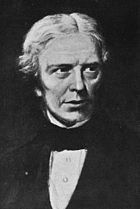Electromagnetic Induction
 Electromagnetic induction is the process by which an e.m.f is induced in a conductor whenever there is change in the magnetic flux linking the conductor. This phenomenon of electromagnetic induction can be explained as follows.
Electromagnetic induction is the process by which an e.m.f is induced in a conductor whenever there is change in the magnetic flux linking the conductor. This phenomenon of electromagnetic induction can be explained as follows.Consider a coil with few number of turns of insulated copper wire and connected to a galvanometer as follows in Figure. When a permanent magnet is moved towards the coil, the pointer of the galvanometer is deflected, thereby indicating the flow of current. This current is due to e.m.f induced in the coil. If movement of the magnet is stopped, though the flux is still linking the coil, the deflection of the galvanometer is reduced to zero, since there is no change in flux.
Now repeat the above process by a coil having more number of turns, or with a stronger magnet or move the magnet with greater speed. In each case greater deflection of the pointer of galvanometer will be observed.
An e.m.f will also be induced in the coil if the magnet is stationary and the coil is in motion.
As explained above when a magnet approaches a coil, e.m.f is induced in it. But the direction of induced current in the coil is such that it develops polarities which oppose the motion of the magnet i.e., when north pole of the magnet is moving towards the coil then the left face of the coil becomes N pole. Thus a force of repulsion will exist between the magnet and coil. When North pole is moving away from the coil the left face of the coil becomes S pole. Thus a force of attraction will exist between the two. In both cases we observe that the effect of induced current is to oppose the motion. If, on the contrary, induced current flows in a direction that the left coil face becomes S pole when north pole magnet is moving towards the coil then due to attraction between unlike poles the magnet will be automatically moving towards the coil. Hence the direction of induced current in the coil is such that it opposes the cause by which it is being induced.
From the above discussion we conclude that
i) E.m.f is induced in a coil only when there is change in the magnetic flux linking the coil.
ii) The magnitude of induced e.m.f depends upon the number of turns of the coil, strength of the magnetic field and the relative motion between the magnetic field and coil.
iii) The direction of induced e.m.f is such that it opposes the cause producing it.
The above conclusions have been incorporated into the various laws of electromagnetic induction explained in the following paragraphs.
Second Law:- The second law states that magnitude of the induced e.m.f is directly proportional to the rate of change of flux lined with the conductor.
Assuming that the coil has N number of turns and the flux linked with the coil changes from the initial value f1wb to the final value f2 wb in t second, then the flux linked is the product of the number of turns and the flux linked with the coil. Then we have initial flux linked = Nf1 ; Final flux linked = Nf2
From the above discussion we conclude that
i) E.m.f is induced in a coil only when there is change in the magnetic flux linking the coil.
ii) The magnitude of induced e.m.f depends upon the number of turns of the coil, strength of the magnetic field and the relative motion between the magnetic field and coil.
iii) The direction of induced e.m.f is such that it opposes the cause producing it.
The above conclusions have been incorporated into the various laws of electromagnetic induction explained in the following paragraphs.
Faraday’s Laws of Electromagnetic Induction
First Law:- Whenever flux linked with a conductor changes, an e.m.f will be induced in that conductor.Second Law:- The second law states that magnitude of the induced e.m.f is directly proportional to the rate of change of flux lined with the conductor.
Assuming that the coil has N number of turns and the flux linked with the coil changes from the initial value f1wb to the final value f2 wb in t second, then the flux linked is the product of the number of turns and the flux linked with the coil. Then we have initial flux linked = Nf1 ; Final flux linked = Nf2
Dynamically Induced e.m.f
Whenever the conductor of length l is made to move in the magnetic field of flux density B with the velocity v, then e.m.f. so induced in the conductor is known as dynamically induced e.m.f. The conductor moves at an angle q with the direction of the lines of force then the induced e.m.f is e=Blv sin q
l = length of conductors in meter
v = velocity of the conductor
f = the angle between the conductor and the line of force
If the circuit of the above induced e.m.f. is completed, a current will flow, which can be called as induced current.
Where as B = flux density in wb/m2
l = length of conductors in meter
v = velocity of the conductor
f = the angle between the conductor and the line of force
If the circuit of the above induced e.m.f. is completed, a current will flow, which can be called as induced current.






No comments:
Post a Comment